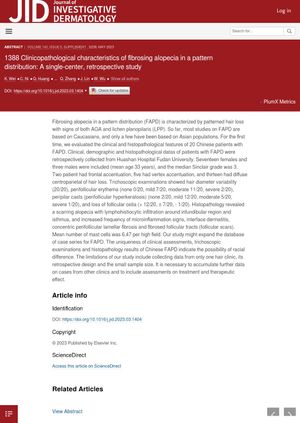Clinicopathological Characteristics of Fibrosing Alopecia in a Pattern Distribution: A Single-Center, Retrospective Study
April 2023
in “
Journal of Investigative Dermatology
”
fibrosing alopecia in a pattern distribution FAPD androgenetic alopecia AGA lichen planopilaris LPP hair diameter variability perifollicular erythema peripilar casts scarring alopecia lymphohistiocytic infiltration infundibular region isthmus microinflammation interface dermatitis concentric perifollicular lamellar fibrosis fibrosed follicular tracts pattern hair loss male pattern baldness female pattern baldness scarring hair loss inflammation skin inflammation hair follicle inflammation

TLDR The study suggests fibrosing alopecia in a pattern distribution has distinct features and may vary by race.
This retrospective study examined the clinical and histopathological features of fibrosing alopecia in a pattern distribution (FAPD) in 20 Chinese patients (17 females and 3 males, average age 33). FAPD is a type of hair loss that shows signs of both androgenetic alopecia (AGA) and lichen planopilaris (LPP). The study found that all patients showed hair diameter variability, while varying degrees of perifollicular erythema and peripilar casts were observed. Histopathology revealed scarring alopecia with lymphohistiocytic infiltration around the infundibular region and isthmus, and an increased frequency of microinflammation signs, interface dermatitis, concentric perifollicular lamellar fibrosis, and fibrosed follicular tracts. The study suggests that there may be racial differences in FAPD, but acknowledges limitations including data collection from a single clinic and a small sample size. Further data from other clinics and assessments on treatment and therapeutic effect are needed.









